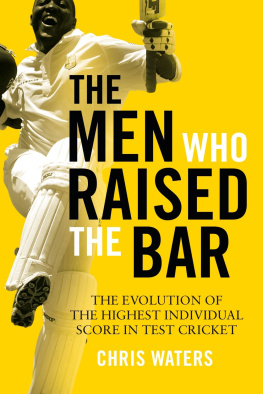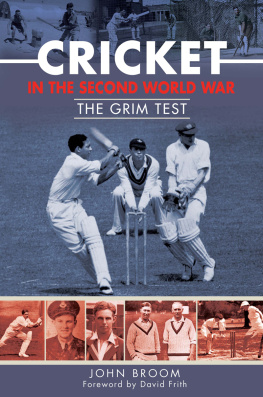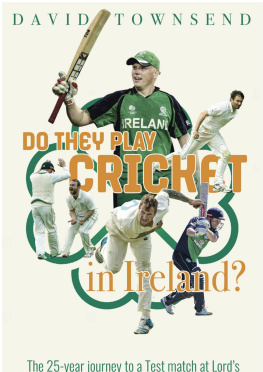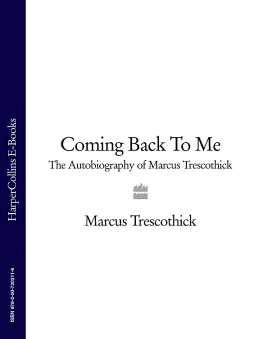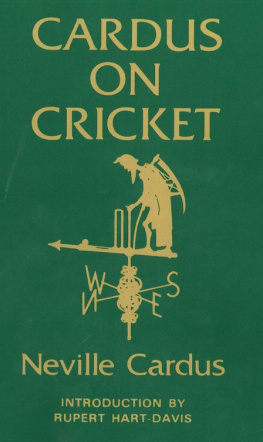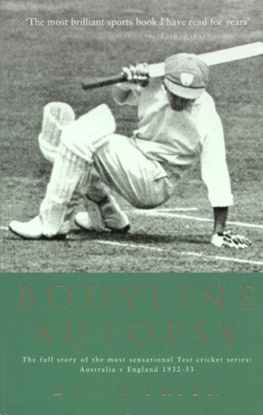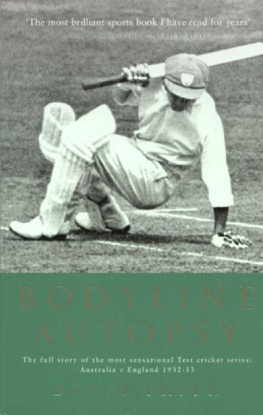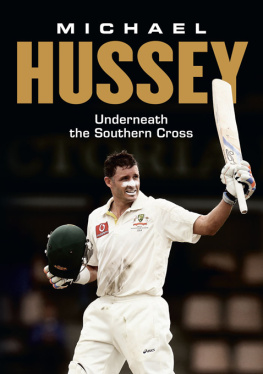
To the record holders, for the pleasure that they gave and the lives that they inspired

Contents
Strictly speaking Charles Bannerman was not one of The Men Who Raised the Bar . The Australian batsman set the bar, leaving it next to 165, a record that stood for seven years. Bannermans score in the very first Test gave the record the perfect start. He faced the opening ball of the game, the story neatly beginning with him. Strictly speaking too, Bannerman did not perform his feat in a Test, or know at the time hed set a record. The match was between a combined Melbourne/Sydney XI and James Lillywhites touring team and only later termed Australia v England. In 1894, Clarence Moody, an Adelaide journalist, wrote in his book Australian Cricket and Cricketers a list of what he considered Test matches. This was accepted by Charles Alcock, the Surrey CCC secretary and leading English authority, and so was born with glorious quaintness the glorious tradition of Test cricket.
Under different circumstances, Bannerman might have been playing for England. He was born in Woolwich, London, in 1851, the son of William Bannerman, a Scotsman, and his wife, Margaret, who came from Ireland. When Charles was two, the Bannermans emigrated when his father a lance-corporal in the Royal Sappers and Miners at the Royal Arsenal, Woolwich was posted to Sydney. The British government had set up a Sydney branch of the Royal Mint to counter a black market in gold at the height of the gold rush, and Bannerman worked in the Mint as a blacksmith. Hed been in Australia for six years when he suddenly died, aged 40, after an attack of delirium tremens (DTs), a condition normally caused by alcohol withdrawal. It left Charless mother with seven children to support including his younger brother, Alec, who also played for Australia.
Charles Bannerman played his earliest cricket at Sydneys Warwick Cricket Club, a stones throw from the Sydney Mint. He was taught by Billy Caffyn, a famous Surrey and England all-rounder, whod stayed in Australia after touring as a player. Practices were staged in the shadow of the Mint where the teenage Charles worked as a mechanic. Bannerman, however, had no time for the job and was cocky and rebellious in his youth. In 1871, one month before his 20th birthday, he was sacked from the Mint having persistently neglected his duty, notwithstanding repeated warnings and opportunities of amendment and having moreover been guilty of insolence to his superior officer and general insubordination. He had a temper too, quitting Warwick CC in a huff to join East Sydney when one of his team-mates earned more than he did for making a big score. The Sydney Mail criticised his childishness, insisting that he was so spoiled and petted by his early cricketing success that he lost his head. Bannerman returned to Warwick a year later and he also represented New South Wales, who then played infrequently against Victoria, then the only other Australian first-class opposition. In the weeks before the first Test, Bannerman played a key role in two wins achieved by New South Wales XVs against James Lillywhites tourists that first gave rise to the idea hitherto thought absurd that Australians could challenge their English counterparts in 11-a-side games. Until then, it was not felt that an Australian XI would be strong enough to compete on equal terms with the English, who often played against up to 22 players to make a game of it. But the success of Bannerman and his colleagues helped inspire a Grand Combination Match (the official title of the first Test), which featured 11 players from Victoria/New South Wales (Melbourne/Sydney) against Lillywhites men.
The Grand Combination Match was not fully representative of Australia or England, with neither side at maximum strength. Internal politics undermined local preparations, with star fast bowler Fred The Demon Spofforth refusing to play because he disapproved of the choice of wicketkeeper. Frank Allan, Spofforths replacement, pulled out to attend an agricultural fair. For their part, England were missing a raft of leading amateurs including star batsman W. G. Grace, with the tourists made up solely of professionals. In addition, their preparation for the Test was somewhat different to the modern routine of pre-match practice days and careful planning. They arrived in Melbourne less than 24 hours before the start of the match after a fraught, six-week sojourn in New Zealand where they had frequent brushes with death in some of the most primitive travelling conditions imaginable. Several players almost drowned while crossing Otira Gorge on South Island, while hair-raising stagecoach journeys threatened life and limb. The side that lined up against Bannerman and co on Thursday, March 15, 1877, for the first Test was shattered and still suffering the after-effects of seasickness (Tom Armitage, a tall and strapping Yorkshire all-rounder, was reportedly so ill that he was barely able to stand up). Nor was it simply a case of leaving him out or any of his colleagues. With every penny eating into profits, the squad consisted of just 12 players, meaning little rest whether fit or not.
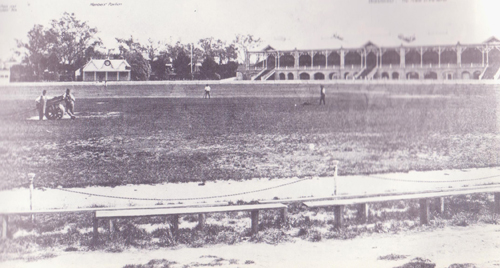
Melbourne Cricket Ground prepares for the Grand Combination Match, later classed as the inaugural Test.
By the time that England got to Melbourne, they were down to the bare bones of 11 after wicketkeeper Ted Pooley had been thrown in jail. Pooley bet a man named Ralph Donkin that he could predict the score of each member of the local 18 in a match against the tourists in Christchurch, nominating nought as each mans figure. Sure enough, a generous number of ducks ensued, leading to a handsome profit. However, Donkin refused to pay and a scuffle took place, resulting in Pooleys arrest and that of Alf Bramall, the touring teams baggage man. Pooley and Bramall were charged with damaging Donkins property and kept in New Zealand pending trial. Their case was not heard until over a fortnight after the Test, whereupon both were acquitted. Considering them hard done to, the locals raised 50 and presented a gold watch to Pooley, who returned to England alone.
In Pooleys absence, and with reserve wicketkeeper Harry Jupp suffering inflammation of the eyes, the short and thickset Nottinghamshire batsman John Selby was pressed into service behind the stumps. Jupp, a broad-shouldered Surrey batsman nicknamed Young Stonewaller, still had to play because there was nobody else. The rest of the side was made up of five Yorkshiremen in the form of the seasick Armitage; the tall pace bowler and hard-hitting batsman George Ulyett; the wiry left-arm quick and attacking batsman Tom Emmett; the diminutive strokeplayer Andrew Greenwood, and the strong right-arm fast bowler Allen Hill. Sussex had two representatives pint-sized Harry Charlwood, a hard-hitting, free-scoring batsman and James Lillywhite himself, a slow and steady left-arm bowler. Short and stocky, with bushy beard, Lillywhite came from a famous cricketing family and was player/captain/manager/tour promoter rolled into one. Alfred Shaw, who assisted him in his managerial role, was another short and stocky fellow. The Nottinghamshire slow-medium bowler was one of the most accurate of all time, sending down more overs in his career than he conceded runs. The attack was completed by Surrey slow bowler James Southerton, who remains the oldest Test debutant at 49.

